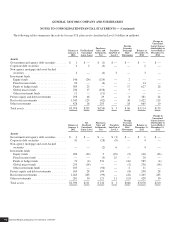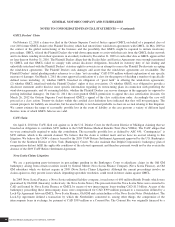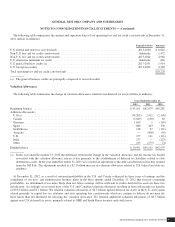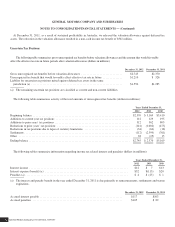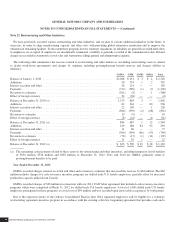General Motors 2012 Annual Report Download - page 149
Download and view the complete annual report
Please find page 149 of the 2012 General Motors annual report below. You can navigate through the pages in the report by either clicking on the pages listed below, or by using the keyword search tool below to find specific information within the annual report.
GENERAL MOTORS COMPANY AND SUBSIDIARIES
NOTES TO CONSOLIDATED FINANCIAL STATEMENTS — (Continued)
GMCL Dealers’ Claim
On February 12, 2010 a claim was filed in the Ontario Superior Court of Justice against GMCL on behalf of a purported class of
over 200 former GMCL dealers (the Plaintiff Dealers) which had entered into wind-down agreements with GMCL. In May 2009 in
the context of the global restructuring of the business and the possibility that GMCL might be required to initiate insolvency
proceedings, GMCL offered the Plaintiff Dealers the wind-down agreements to assist with their exit from the GMCL dealer network
and to facilitate winding down their operations in an orderly fashion by December 31, 2009 or such other date as GMCL approved but
no later than on October 31, 2010. The Plaintiff Dealers allege that the Dealer Sales and Service Agreements were wrongly terminated
by GMCL and that GMCL failed to comply with certain disclosure obligations, breached its statutory duty of fair dealing and
unlawfully interfered with the Plaintiff Dealers’ statutory right to associate in an attempt to coerce the Plaintiff Dealers into accepting
the wind-down agreements. The Plaintiff Dealers seek damages and assert that the wind-down agreements are rescindable. The
Plaintiff Dealers’ initial pleading makes reference to a claim “not exceeding” CAD $750 million without explanation of any specific
measure of damages. On March 1, 2011 the court approved certification of a class for the purpose of deciding a number of specifically
defined issues including: (1) whether GMCL breached its obligation of “good faith” in offering the wind-down agreements;
(2) whether GMCL interfered with the Plaintiff Dealers’ rights of free association; (3) whether GMCL was obligated to provide a
disclosure statement and/or disclose more specific information regarding its restructuring plans in connection with proffering the
wind-down agreements; and (4) assuming liability, whether the Plaintiff Dealers can recover damages in the aggregate (as opposed to
proving individual damages). On June 22, 2011 the court granted GMCL permission to appeal the class certification decision. On
March 26, 2012 the Ontario Superior Court dismissed GMCL’s appeal of the class certification order. Accordingly the case will
proceed as a class action. Twenty-six dealers within the certified class definition have indicated that they will not participate. The
current prospects for liability are uncertain, but because liability is not deemed probable we have no accrual relating to this litigation.
We cannot estimate the range of reasonably possible loss in the event of liability as the case presents a variety of different legal
theories, none of which GMCL believes are valid.
UAW Claim
On April 6, 2010 the UAW filed suit against us in the U.S. District Court for the Eastern District of Michigan claiming that we
breached an obligation to contribute $450 million to the UAW Retiree Medical Benefits Trust (New VEBA). The UAW alleges that
we were contractually required to make this contribution. The reasonably possible loss as defined by ASC 450, “Contingencies” is
$450 million, which is the amount claimed. We believe that the claim is without merit and we have no accrual relating to this
litigation. We believe the UAW’s claim is barred by the 2009 UAW Retiree Settlement Agreement approved by the U.S. Bankruptcy
Court for the Southern District of New York (Bankruptcy Court). We also maintain that Delphi Corporation’s bankruptcy plan of
reorganization did not fulfill the applicable conditions of the relevant agreement and therefore payment would not be due even in the
absence of the 2009 UAW Retiree Settlement Agreement.
Nova Scotia Claims Litigation
We are a participating party-in-interest in proceedings pending in the Bankruptcy Court to adjudicate claims in the Old GM
bankruptcy arising from certain securities issued by General Motors Nova Scotia Finance Company (Nova Scotia Finance), an Old
GM subsidiary which we did not acquire in 2009 (Nova Scotia Claims Litigation). Although the current proceedings involve no
claims against us, they present issues which, depending upon their resolution, could result in future claims against GMCL.
In 2003 Nova Scotia Finance, a Nova Scotia unlimited liability company, issued notes of 600 million British Pounds which were
guaranteed by Old GM (Guaranty) (collectively, the Nova Scotia Notes). The proceeds from the Nova Scotia Notes were converted to
CAD and loaned by Nova Scotia Finance to GMCL by means of two intercompany loans totaling CAD $1.3 billion. As part of the
bankruptcy proceeding these intercompany loans were compromised for CAD $399 million pursuant to a transaction defined by a
Lock-Up Agreement between GMCL, Nova Scotia Finance, Old GM and certain holders of the Nova Scotia Notes (Noteholders). The
Lock-Up Agreement defined a transaction by which the Noteholders consented to, among other things, the compromise of the
intercompany loans in exchange for payment of CAD $399 million as a Consent Fee. The Consent Fee was originally financed by a
General Motors Company 2012 ANNUAL REPORT146


